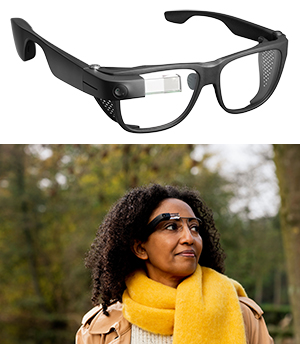Empowering Independence With Assistive Modern Technology for the Blind
The combination of assistive modern technology for people who are blind or visually impaired stands for a significant development in cultivating independence and improving high quality of life. With a variety of devices-- from screen readers to cutting-edge tactile devices-- these modern technologies not just help with navigating and communication yet also advertise social incorporation and participation in various elements of life.
Recognizing Assistive Technology
Although assistive technology has evolved substantially for many years, its essential function continues to be the same: to enhance the lifestyle for individuals with handicaps, specifically those that are visually damaged or blind. This innovation includes a wide series of devices and devices that help with independence and functionality in everyday tasks.
Assistive innovation can be categorized into low-tech and modern options, each created to meet specific demands. Modern devices commonly include software applications, specialized hardware, and flexible devices that use innovative technology to give assistance in different contexts. Alternatively, low-tech remedies may involve day-to-day items that are modified to enhance availability, such as magnifiers or tactile pens.
The assimilation of assistive modern technology into the lives of people who are blind or visually harmed not just advertises freedom but additionally fosters social incorporation and participation in expert and academic settings. By leveraging these innovations, customers can navigate their environments, gain access to details, and interact efficiently, thus boosting their total lifestyle. Recognizing assistive modern technology is important for supporters, specialists, and caretakers that intend to support people in maximizing their prospective and attaining higher freedom.
Sorts Of Assistive Tools
Assistive gadgets for the blind and aesthetically impaired are important tools that improve daily living by dealing with particular challenges run into by individuals. These tools can be broadly categorized right into three major kinds: optical devices, electronic devices, and sensory tools.

Sensory gadgets, such as Braille display screens and tactile maps, give alternate means to obtain info. Braille displays transform digital message into Braille, allowing customers to review via touch. Tactile maps offer spatial understanding through raised textures and lines, enabling much better ecological understanding.
Together, these assistive gadgets encourage people with aesthetic disabilities to involve more totally with their environments, advertising greater independence and self-confidence in day-to-day activities.

Influence On Life
The integration of assistive innovation right into the lives of individuals who are visually damaged or blind dramatically boosts their capability to engage and browse with the globe around them. Gadgets such as screen readers, Braille shows, and mobile applications assist in access to information, enabling users to involve with digital content, communicate effectively, and take care of day-to-day tasks individually.
Furthermore, technologies like smart glasses and navigation applications give real-time help in unfamiliar settings, boosting wheelchair and confidence. These devices allow users find here to determine barriers, read indicators, and even acknowledge faces, hence fostering a feeling of autonomy in public spaces. In addition, home automation systems, which can be controlled through voice commands, permit individuals to handle their living atmospheres more effectively, boosting comfort and security.
The influence of assistive innovation extends past useful tasks; it advertises social addition and emotional well-being. By connecting the gap in between people and their environments, these technologies equip customers to optometric physician vs optometrist take part fully in neighborhood tasks, go after instructional chances, and engage in significant partnerships. Ultimately, the innovation of assistive modern technology contributes in redefining the possibilities for people who are blind or aesthetically impaired, leading to a much more easily accessible and inclusive society.
Success Stories and Testimonies

One more powerful review comes from Mark, a recent university grad that made use of display analysis software program throughout his scholastic journey. This technology enabled him to accessibility course materials and take part in conversations, eventually leading to his effective change right into the workforce. Mark credit histories assistive modern technology for empowering him to attain his occupation goals, emphasizing its function in leveling the having fun field for individuals with visual disabilities.
Furthermore, recreation center have actually reported boosted participation in their programs many thanks to the introduction of easily accessible digital platforms. These systems have made it much easier for individuals to link, share resources, and support each other. These success stories collectively emphasize the extensive effect of assistive modern technology in cultivating freedom, enhancing high quality of life, and breaking down barriers for the blind and visually damaged community.
Future Trends in Assistive Tech
Emerging modern technologies are positioned to transform the landscape of assistive tech for people that are aesthetically impaired or blind. Advancements in expert system (AI) and artificial intelligence are improving the capabilities of gadgets, enabling even more user-friendly customer experiences. For example, AI-driven applications are significantly able to check out and identify things text out loud in real-time, supplying individuals with important details about their environments.
Furthermore, developments in wearable modern technology are developing brand-new opportunities for freedom. Smart glasses outfitted with increased fact functions can overlay essential details onto the pop over here individual's field of vision, promoting navigation and communication with the setting. Moreover, the integration of Net of Points (IoT) devices is enhancing accessibility in smart homes, enabling individuals to regulate devices and obtain alerts via voice commands or tactile interfaces.
The advancement of braille displays and responsive feedback systems is also rising, promoting accessibility to digital material and boosting interaction. As these technologies remain to progress, they promise to improve daily living, educational possibilities, and employment leads for people with aesthetic disabilities. Continuous cooperation between engineers, users, and advocacy groups will be essential in guaranteeing these innovations fulfill the needs of the neighborhood properly.
Conclusion
In conclusion, assistive technology plays an essential duty in improving the self-reliance of people who are blind or visually impaired. By giving crucial tools and resources, these innovations help with boosted accessibility, interaction, and navigating to info, therefore promoting autonomy and positive self-image. The transformative impact of assistive gadgets not only promotes effective interaction with the atmosphere however additionally urges social addition and participation in numerous facets of life, ultimately empowering users to grow within their areas.
The integration of assistive innovation for individuals that are blind or visually impaired represents a significant improvement in cultivating freedom and improving quality of life.The assimilation of assistive technology right into the lives of people that are blind or visually impaired not only promotes autonomy yet also fosters social incorporation and involvement in educational and expert environments. Ultimately, the advancement of assistive modern technology is critical in redefining the opportunities for individuals that are blind or visually damaged, leading to a more comprehensive and easily accessible society.
Several individuals that are blind or visually damaged have actually shared motivating success stories that highlight the transformative impact of assistive technology on their lives.In verdict, assistive technology plays a pivotal duty in improving the self-reliance of people that are blind or aesthetically impaired.
 Michael C. Maronna Then & Now!
Michael C. Maronna Then & Now! Samantha Fox Then & Now!
Samantha Fox Then & Now! Heather Locklear Then & Now!
Heather Locklear Then & Now! Andrew McCarthy Then & Now!
Andrew McCarthy Then & Now! Christy Canyon Then & Now!
Christy Canyon Then & Now!